Double Pointed Needles
You can use double pointed needles to knit tubes of fabric with small circumferences. Examples would be socks, hats and the sleeves of sweaters. Double pointed needles (commonly referred to as dpns) come in packages of 4, 5 or sometimes 6 needles. You can choose to knit around 3 or 4 needles, depending on the size of your project and your personal preference. Our example below will demonstrate knitting in the round over 3 needles, using a 4th needle to complete the knit stitches.
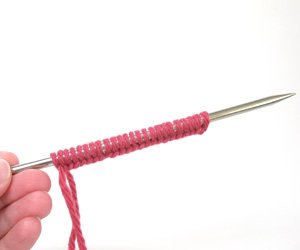 First, begin by casting on the required number of stitches onto one of the double pointed needles.
First, begin by casting on the required number of stitches onto one of the double pointed needles.
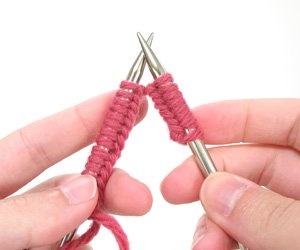 Slip one third of the stitches purlwise onto a second double pointed needle.
Slip one third of the stitches purlwise onto a second double pointed needle.
 Repeat for with the third double pointed needle, leaving you with your stitches divided amongst the three needles.
Repeat for with the third double pointed needle, leaving you with your stitches divided amongst the three needles.
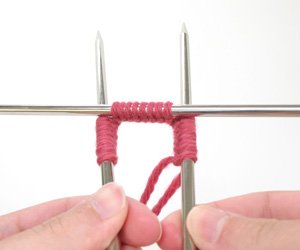 Arrange your needles in an “H” shape with the working yarn hanging off of the righthand needle as pictured to the right. Make sure that the stitches do not twist around any of the needles. The cast on edge should face downward on all three needles.
Arrange your needles in an “H” shape with the working yarn hanging off of the righthand needle as pictured to the right. Make sure that the stitches do not twist around any of the needles. The cast on edge should face downward on all three needles.
 Slide the stitches on the lefthand needle down to the tip closest to you. These are the stitches you will be knitting first.
Slide the stitches on the lefthand needle down to the tip closest to you. These are the stitches you will be knitting first.
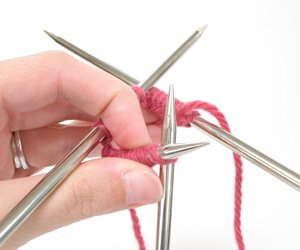 Insert your fourth needle (the empty one) into the first stitch on the lefthand needle.
Insert your fourth needle (the empty one) into the first stitch on the lefthand needle.
 Grasp the working yarn with your right hand and work the stitch you have just inserted your fourth needle into. You have just joined the stitches and are effectively working in the round!
Grasp the working yarn with your right hand and work the stitch you have just inserted your fourth needle into. You have just joined the stitches and are effectively working in the round!
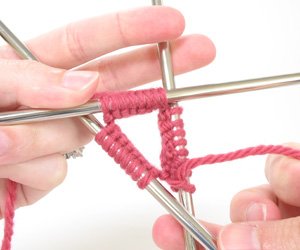 Work the rest of the stitches until you have freed up a needle. You will now use this free needle to work the next set of stitches on the needle to the left of the working yarn.
Work the rest of the stitches until you have freed up a needle. You will now use this free needle to work the next set of stitches on the needle to the left of the working yarn.
Remember, if you put down your work and can’t figure out where you left off, you should always be working the stitches on the needle that is to the left of the one with the working yarn hanging from it. It is very helpful to use a stitch marker to mark the beginning of the round. However, you may want to shift the stitches so that the marker does not fall between two sets of stitches as it can slip off of the end of a needle. Make sure the first stitch on each new needle is worked snugly, as this will prevent any looseness from appearing in your piece between needles.

